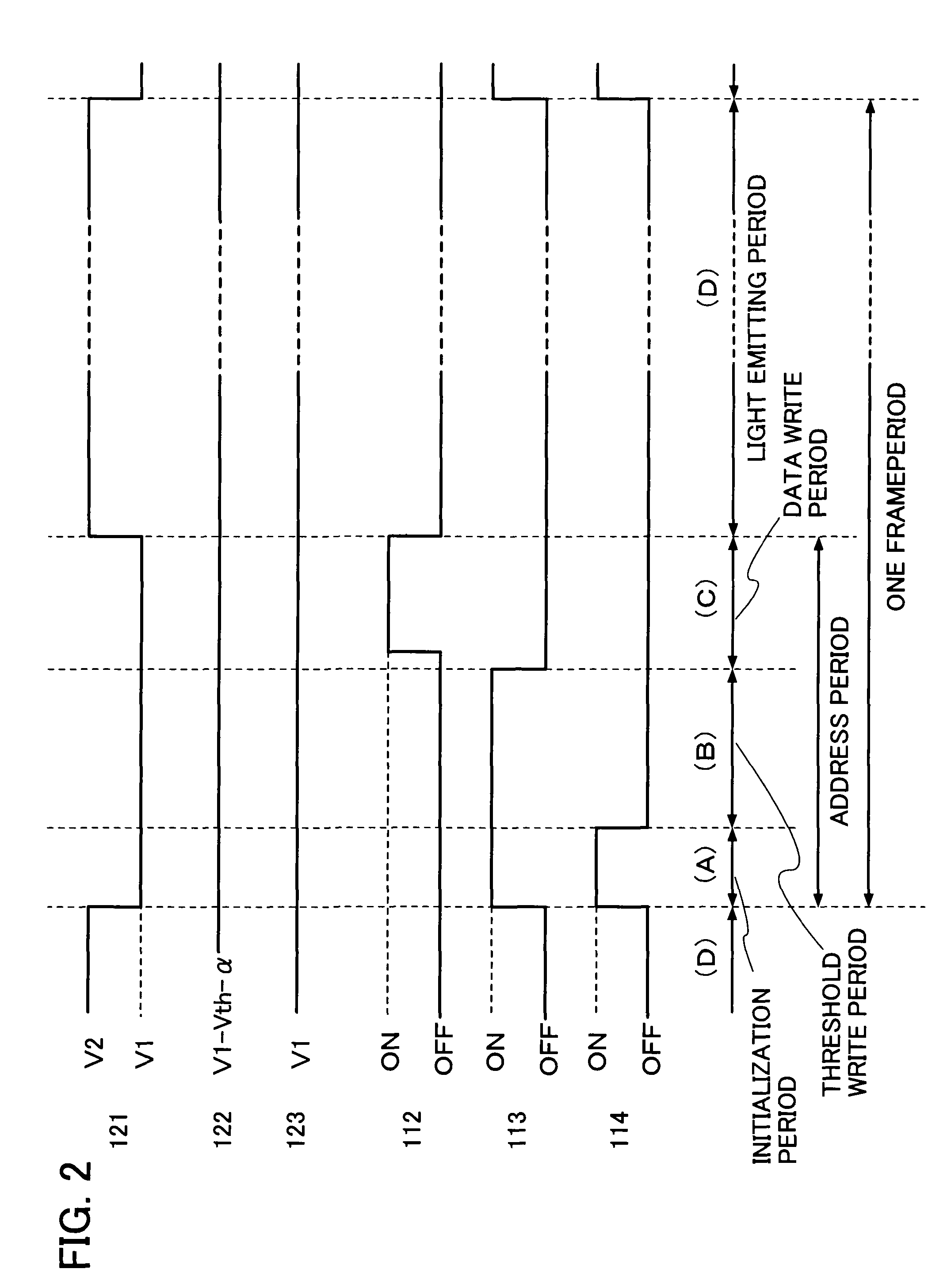Semiconductor device, display device, and electronic device
a technology of semiconductor devices and display devices, applied in static indicating devices, instruments, electroluminescent light sources, etc., can solve the problems of increase of voltage applied to light emitting elements and power consumption, and easy deterioration of light emitting elements or drive transistors. , to achieve the effect of suppressing the current value caused by the threshold voltage variation of transistors, less luminance variation, and high duty ratio
- Summary
- Abstract
- Description
- Claims
- Application Information
AI Technical Summary
Benefits of technology
Problems solved by technology
Method used
Image
Examples
embodiment mode 1
[0094]A basic structure of a pixel of the present invention is explained with reference to FIG. 1. The pixel shown in FIG. 1 includes a transistor 111, a first switch 112, a second switch 113, a third switch 114, a capacitor 115, and a light emitting element 116. Note that the pixel is connected to a signal line 117, a first scan line 118, a second scan line 119, a third scan line 120, a power supply line 121, and a potential supply line 122. In this embodiment mode, the transistor 111 is an n-channel transistor and is turned on when a gate-source voltage (Vgs) thereof exceeds a threshold voltage (Vth). In addition, a pixel electrode of the light emitting element 116 is an anode and an opposite electrode 123 is a cathode. Note that the gate-source voltage of the transistor is referred to as Vgs; a drain-source voltage, Vds; a threshold voltage, Vth; a voltage accumulated in the capacitor, Vcs; and the power supply line 121, the potential supply line 122, and the signal line 117 are ...
embodiment mode 2
[0144]In this embodiment mode, a pixel with a structure different from Embodiment Mode 1 is explained with reference to FIGS. 39A and 39B. Note that a common reference numeral is used to denote a component similar to Embodiment Mode 1, and detailed explanation of the same portion or a portion having a similar function is omitted.
[0145]The pixel shown in FIG. 39A includes a transistor 111, a first switch 112, a second switch 113, a rectifier element 3914, a capacitor 115, and a light emitting element 116. Note that the pixel is connected to a signal line 117, a first scan line 118, a second scan line 119, a third scan line 3920, and a power supply line 121. The pixel shown in FIG. 39A has a structure in which the rectifier element 3914 is used as the third switch 114 in FIG. 1, and a second electrode of the capacitor 115, a first electrode of the transistor 111, and a pixel electrode of the light emitting element 116 are connected to the third scan line 3920 through the rectifier ele...
embodiment mode 3
[0151]In this embodiment mode, pixels having structures different from those in Embodiment Mode 1 are explained with reference to FIGS. 7 to 9. Note that a common reference numeral is used to denote a component similar to Embodiment Mode 1, and detailed explanation of the same portion or a portion having a similar function is omitted.
[0152]A pixel 700 shown in FIG. 7 includes a transistor 111, a first switch 112, a second switch 113, a third switch 114, a capacitor 115, and a light emitting element 116. Note that the pixel 700 is connected to a signal line 117, a first scan line 718, a second scan line 119, a third scan line 120, a power supply line 121, and a first pixel line 718 of a subsequent row.
[0153]In the pixel of FIG. 1 described in Embodiment Mode 1, the first electrode of the transistor 111 is connected to the potential supply line 122 through the third switch 114, while it can be connected to the first scan line 718 of the subsequent row in FIG. 7. This is because the po...
PUM
 Login to View More
Login to View More Abstract
Description
Claims
Application Information
 Login to View More
Login to View More - R&D
- Intellectual Property
- Life Sciences
- Materials
- Tech Scout
- Unparalleled Data Quality
- Higher Quality Content
- 60% Fewer Hallucinations
Browse by: Latest US Patents, China's latest patents, Technical Efficacy Thesaurus, Application Domain, Technology Topic, Popular Technical Reports.
© 2025 PatSnap. All rights reserved.Legal|Privacy policy|Modern Slavery Act Transparency Statement|Sitemap|About US| Contact US: help@patsnap.com



